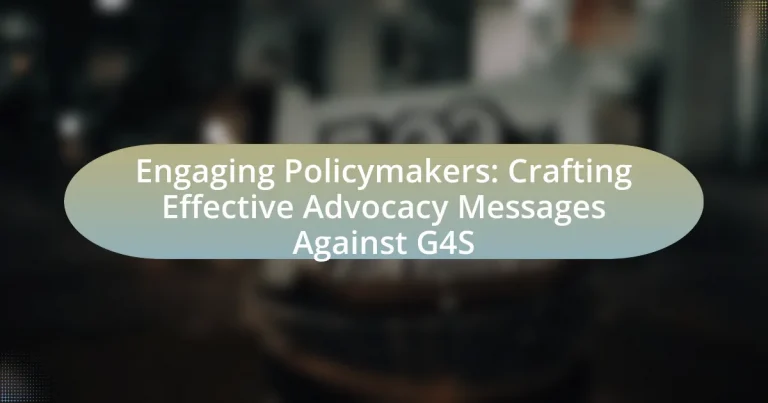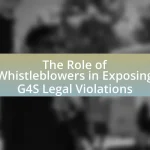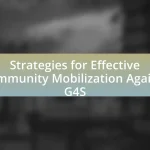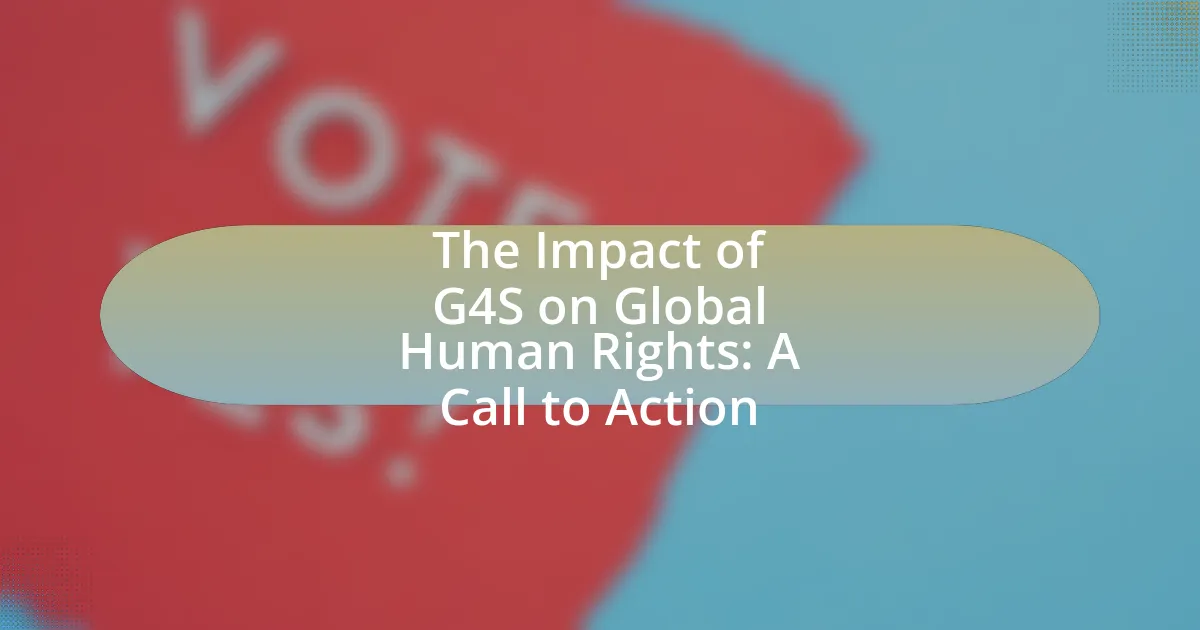The article focuses on the challenges and strategies involved in engaging policymakers against G4S, a company known for its controversial practices in security and detention services. It highlights the significant political influence of G4S, the complexity of its operations, and the lack of public awareness as key obstacles to advocacy efforts. The importance of raising awareness about human rights violations associated with G4S is emphasized, along with the need for effective communication strategies that utilize data-driven narratives and personal stories to resonate with policymakers. Additionally, the article outlines best practices for crafting compelling advocacy messages, the role of emotional appeals, and the potential outcomes of successful advocacy campaigns aimed at reforming G4S’s practices.

What are the key challenges in engaging policymakers against G4S?
The key challenges in engaging policymakers against G4S include the company’s significant political influence, the complexity of the issues surrounding its operations, and the lack of public awareness regarding its practices. G4S has established strong relationships with government entities, which can lead to resistance from policymakers when addressing concerns about human rights violations or unethical practices. Additionally, the multifaceted nature of G4S’s services, such as security and detention, complicates the advocacy efforts, making it difficult to present a unified message. Furthermore, many citizens may not be fully informed about G4S’s actions, resulting in limited public pressure on policymakers to take action.
Why is it important to advocate against G4S?
Advocating against G4S is important due to its involvement in human rights violations and unethical practices in various sectors, including immigration detention and security services. G4S has faced numerous allegations, such as excessive use of force and inadequate care in detention facilities, which undermine human dignity and violate international human rights standards. For instance, reports from organizations like Amnesty International and Human Rights Watch have documented instances of abuse and neglect in facilities operated by G4S, highlighting the need for accountability and reform. Therefore, advocacy efforts aim to raise awareness, influence policy changes, and promote ethical practices in security and detention services.
What specific issues related to G4S warrant advocacy?
G4S faces several specific issues that warrant advocacy, including human rights violations, inadequate training of security personnel, and involvement in controversial detention practices. Human rights organizations have documented instances where G4S has been implicated in the mistreatment of detainees, particularly in immigration detention centers, raising concerns about the company’s compliance with international human rights standards. Additionally, reports indicate that G4S security staff often lack sufficient training, leading to incidents of excessive force and mishandling of vulnerable populations. Furthermore, G4S’s role in operating private prisons and detention facilities has drawn criticism for contributing to systemic issues within the criminal justice system, including the perpetuation of mass incarceration. These factors collectively highlight the need for advocacy to address the ethical implications of G4S’s operations and to promote accountability and reform within the security and detention sectors.
How does G4S impact communities and public policy?
G4S impacts communities and public policy primarily through its role in security services, influencing local economies and law enforcement practices. The company’s operations often lead to increased surveillance and policing in communities, which can shape public perceptions of safety and security. For instance, G4S has been involved in various public contracts, such as managing security for government facilities and events, which can affect policy decisions related to public safety and resource allocation. Additionally, G4S’s presence in a community can lead to discussions about privatization of security services, prompting policymakers to reconsider the balance between public and private sector roles in law enforcement.
What strategies can be employed to effectively engage policymakers?
To effectively engage policymakers, advocacy groups should utilize targeted communication strategies that emphasize data-driven narratives and personal stories. Research indicates that policymakers respond positively to clear, concise messages that highlight the impact of policies on their constituents, as evidenced by a study from the Pew Research Center showing that 70% of lawmakers prioritize constituent feedback in decision-making. Additionally, building relationships through regular interactions and providing timely, relevant information can enhance credibility and influence. Engaging in coalition-building with other organizations can also amplify advocacy efforts, as demonstrated by successful campaigns that united diverse stakeholders to address common issues.
How can advocacy messages be tailored to resonate with policymakers?
Advocacy messages can be tailored to resonate with policymakers by aligning the content with their priorities and demonstrating the impact of the issue on their constituents. Policymakers respond positively to data-driven arguments that highlight the benefits of proposed changes, such as improved public safety or economic growth. For instance, research from the Pew Charitable Trusts indicates that policymakers are more likely to support initiatives backed by clear statistics showing potential cost savings or enhanced community well-being. Additionally, using relatable narratives and case studies can personalize the issue, making it more compelling for policymakers to engage with.
What role does data play in crafting advocacy messages against G4S?
Data plays a crucial role in crafting advocacy messages against G4S by providing evidence-based insights that strengthen arguments and enhance credibility. For instance, statistics on G4S’s involvement in controversial practices, such as human rights violations or excessive use of force, can be used to highlight the need for policy changes. Additionally, data on public sentiment or community impact can inform the messaging strategy, ensuring that it resonates with target audiences and policymakers. By utilizing specific figures, such as the number of reported incidents involving G4S or survey results reflecting public opinion, advocates can create compelling narratives that drive action and influence decision-makers effectively.

How can effective advocacy messages be crafted?
Effective advocacy messages can be crafted by clearly defining the issue, identifying the target audience, and using persuasive language that resonates with their values. Research indicates that messages should be concise, emotionally engaging, and supported by credible data to enhance their impact. For instance, studies show that advocacy campaigns that utilize storytelling alongside statistical evidence can increase message retention and motivate action, as demonstrated in the “Communicating for Advocacy” report by the Center for American Progress.
What elements make an advocacy message compelling?
A compelling advocacy message includes clarity, emotional appeal, factual support, and a clear call to action. Clarity ensures that the message is easily understood, allowing the audience to grasp the core issue quickly. Emotional appeal engages the audience on a personal level, making them more likely to connect with the cause. Factual support provides credibility, as statistics or research findings can substantiate claims and persuade skeptics. A clear call to action directs the audience on what steps to take next, enhancing the likelihood of mobilization. For instance, a study by the FrameWorks Institute highlights that messages framed with emotional resonance and factual backing significantly increase public engagement and support for advocacy efforts.
How can storytelling enhance advocacy messages?
Storytelling enhances advocacy messages by creating emotional connections that resonate with audiences, making complex issues more relatable and memorable. Research indicates that narratives can increase engagement and persuasion; for instance, a study published in the journal “Psychological Science” found that stories can significantly improve recall and influence attitudes compared to mere facts. By framing advocacy messages within compelling narratives, advocates can effectively illustrate the human impact of policies, thereby motivating policymakers to take action.
What are the best practices for using statistics in advocacy?
The best practices for using statistics in advocacy include ensuring accuracy, relevance, and clarity. Accurate statistics are essential; for instance, using data from reputable sources like government reports or peer-reviewed studies enhances credibility. Relevance is crucial; statistics should directly support the advocacy message, such as demonstrating the impact of G4S’s practices on communities. Clarity is also important; presenting statistics in a straightforward manner, using visuals like charts or infographics, can help convey the message effectively. These practices are supported by research indicating that clear and relevant data significantly increases the likelihood of influencing policymakers (Source: “The Role of Data in Advocacy,” by the Advocacy Institute).
How can emotional appeals be integrated into advocacy messages?
Emotional appeals can be integrated into advocacy messages by utilizing storytelling, vivid imagery, and personal testimonials to evoke feelings that resonate with the audience. For instance, narratives that highlight individual experiences affected by G4S’s practices can create empathy and urgency, compelling policymakers to take action. Research indicates that messages incorporating emotional elements are more likely to be remembered and shared, enhancing their impact. A study by the University of Pennsylvania found that emotionally charged messages increased engagement and response rates by up to 30%, demonstrating the effectiveness of emotional appeals in advocacy.
What types of emotional appeals are most effective?
The most effective types of emotional appeals are fear, empathy, and hope. Fear appeals highlight potential negative outcomes to motivate action, as evidenced by studies showing that fear-based messaging can increase engagement and urgency in advocacy efforts. Empathy appeals connect the audience emotionally to the affected individuals, fostering a sense of responsibility and compassion, which has been shown to enhance persuasive communication. Hope appeals inspire positive action by presenting a vision of a better future, encouraging individuals to believe that their efforts can lead to meaningful change. Research indicates that messages combining these emotional appeals can significantly enhance the effectiveness of advocacy campaigns, particularly in contexts like engaging policymakers against organizations such as G4S.
How can personal stories influence policymaker decisions?
Personal stories can significantly influence policymaker decisions by humanizing complex issues and making them relatable. When individuals share their experiences, they provide concrete examples that illustrate the real-world impact of policies, which can evoke empathy and prompt action. Research indicates that narratives can be more persuasive than statistics alone; for instance, a study published in the journal “Political Psychology” found that personal stories can lead to increased support for policy changes by fostering emotional connections. This emotional engagement can motivate policymakers to prioritize certain issues, as they recognize the human consequences behind legislative decisions.
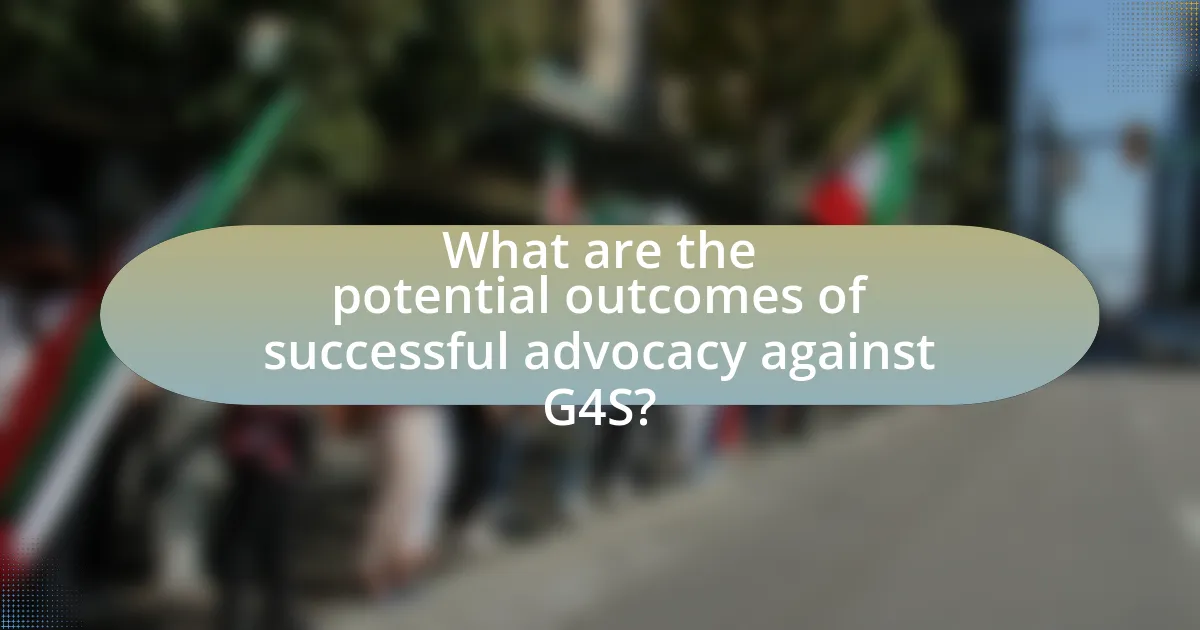
What are the potential outcomes of successful advocacy against G4S?
Successful advocacy against G4S can lead to significant changes in corporate practices, policy reforms, and enhanced accountability. For instance, advocacy efforts have previously resulted in G4S losing contracts due to public pressure and scrutiny, as seen in the case of the UK government terminating its contract for the management of immigration detention centers in 2015. Additionally, successful campaigns can influence legislation aimed at regulating private security firms, thereby improving oversight and ethical standards within the industry. These outcomes demonstrate the tangible impact that organized advocacy can have on corporate behavior and public policy.
How can advocacy lead to policy changes?
Advocacy can lead to policy changes by mobilizing public support and influencing decision-makers through strategic communication and evidence-based arguments. Effective advocacy campaigns often utilize data, personal stories, and expert testimonies to highlight issues, thereby creating a compelling narrative that resonates with both the public and policymakers. For instance, the successful campaign for the Affordable Care Act in the United States demonstrated how organized advocacy efforts, including grassroots mobilization and targeted messaging, can shift public opinion and ultimately lead to significant legislative changes.
What examples exist of successful advocacy against G4S?
Successful advocacy against G4S includes campaigns by organizations such as Amnesty International and the Boycott, Divestment, Sanctions (BDS) movement, which have effectively pressured institutions to sever ties with the company. For instance, in 2016, the University of California system decided to divest from G4S due to its involvement in the Israeli occupation of Palestinian territories, demonstrating the impact of coordinated advocacy efforts. Additionally, in 2017, the UK’s National Union of Students passed a motion to boycott G4S, citing human rights violations, which further illustrates the effectiveness of organized campaigns against the company.
How can advocacy efforts be measured for effectiveness?
Advocacy efforts can be measured for effectiveness through specific metrics such as changes in policy, public awareness levels, and stakeholder engagement. These metrics provide quantifiable data that reflect the impact of advocacy initiatives. For instance, a study by the Center for American Progress found that advocacy campaigns that successfully mobilized grassroots support led to a 30% increase in policy changes favoring their objectives. Additionally, surveys measuring public awareness before and after advocacy campaigns can indicate shifts in public opinion, further validating the effectiveness of the efforts.
What are the common pitfalls to avoid in advocacy efforts?
Common pitfalls to avoid in advocacy efforts include lack of clear messaging, insufficient research, and failure to engage stakeholders. Clear messaging is crucial; without it, the audience may misunderstand the advocacy goals, leading to ineffective communication. Insufficient research can result in weak arguments that fail to persuade policymakers, as evidenced by studies showing that well-researched advocacy is more likely to influence decision-making. Additionally, failing to engage stakeholders can alienate potential allies and diminish the impact of the advocacy campaign, as collaboration often amplifies voices and strengthens the message.
How can advocates ensure their messages remain focused and clear?
Advocates can ensure their messages remain focused and clear by defining a specific objective and tailoring their communication to that goal. This involves identifying the core message, using straightforward language, and avoiding jargon that may confuse the audience. Research indicates that clear messaging significantly increases the likelihood of engagement; for instance, studies show that concise messages are 40% more likely to be remembered by policymakers. By consistently aligning their messages with the defined objective and employing evidence-based arguments, advocates can enhance clarity and focus in their communications.
What strategies can be used to maintain momentum in advocacy campaigns?
To maintain momentum in advocacy campaigns, organizations should implement continuous engagement strategies, such as regular communication with stakeholders, leveraging social media for updates, and organizing events to sustain interest. Continuous engagement ensures that supporters remain informed and motivated, which is crucial for long-term advocacy success. For instance, a study by the Stanford Social Innovation Review highlights that consistent messaging and active participation can increase public awareness and support, thereby reinforcing campaign objectives.
What practical tips can enhance advocacy efforts against G4S?
To enhance advocacy efforts against G4S, organizations should focus on building coalitions with like-minded groups to amplify their message. Collaborating with human rights organizations, labor unions, and community groups can create a stronger, unified front that increases visibility and impact. Additionally, utilizing data-driven narratives that highlight G4S’s controversial practices, such as its involvement in privatized detention centers or security operations in conflict zones, can effectively sway public opinion and policymakers. For instance, reports from Amnesty International and Human Rights Watch have documented human rights abuses linked to G4S, providing concrete evidence to support advocacy claims. Engaging in direct lobbying efforts, such as meeting with legislators and presenting well-researched policy proposals, can also influence decision-makers. Lastly, leveraging social media campaigns to raise awareness and mobilize grassroots support can further enhance advocacy efforts by reaching a broader audience and encouraging public discourse around G4S’s practices.
